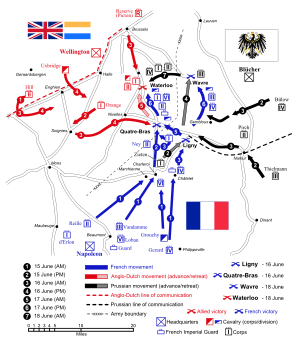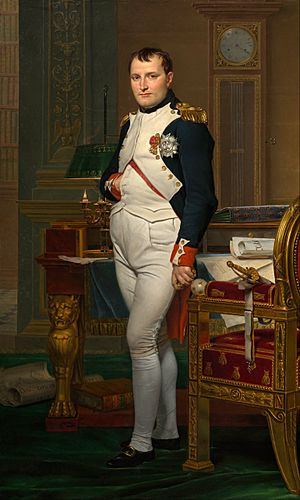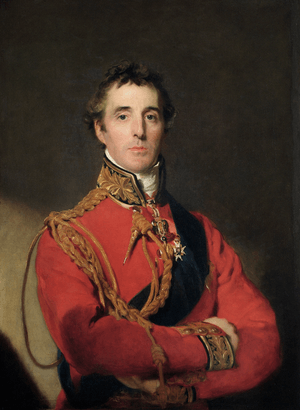Order of battle of the Waterloo campaign facts for kids
This article lists the different armies and their main parts that fought in the Waterloo campaign. An "order of battle" is like a detailed list showing how an army is organized, who leads each part, and how many soldiers and weapons they have. This helps us understand how these huge armies were put together for the big battles like Quatre Bras, Ligny, and Waterloo in June 1815.
Contents
French Army: How it was Organized
The French army, called L'Armée du Nord (Army of the North), was led by Emperor Napoleon I. His main helper, like a chief of staff, was Marshal Soult.
Here are some of the key commanders and their roles:
- Marshal Ney: He led the Left Wing of the army.
- On June 16, 1815, at the Battle of Quatre Bras, he commanded the I Corps, II Corps (except for one division), and some cavalry.
- On June 18, 1815, at the Battle of Waterloo, he was the main field commander for most French forces.
- Marshal Marquis de Grouchy: He led the Right Wing.
- On June 16, 1815, at the Battle of Ligny, he commanded the French Cavalry Reserve.
- From June 17-19, 1815, he led the III Corps, IV Corps, and some cavalry.
French Army Corps and Divisions
The French army was divided into large groups called Corps, each with its own commander and smaller units like divisions and brigades.
I Corps: Commander and Units
The I Corps was led by Général de Division Comte Jean-Baptiste Drouet d'Erlon. This corps had about 19,357 soldiers and 44 cannons. It included:
- 1st Infantry Division: Led by Général de Brigade Baron Joachim Jérôme Quiot du Passage.
- 2nd Division: Led by Général de Division Baron François-Xavier Donzelot.
- 3rd Division: Led by Général de Division Baron Pierre-Louis Binet de Marcognet.
- 4th Division: Led by Général de Division Comte Pierre François Joseph Durutte.
- 1st Light Cavalry Division: Led by Général de Division Baron Charles Claude Jacquinot. This division had light cavalry units like Hussars and Lancers.
- I Corps Artillery Reserve: Commanded by Général de Brigade Jean-Charles De Salles.
II Corps: Commander and Units
The II Corps was commanded by Général de Division Comte Honoré Charles Reille. It had about 22,731 soldiers and 32 cannons. Key divisions included:
- 5th Division: Led by Général de Division Baron Gilbert Bachelu.
- 6th Division: Led by Général de Division Prince Jérôme Bonaparte, Napoleon's younger brother.
- 7th Division: Led by Général de Division Baron Jean Baptiste Girard.
- 9th Division: Led by Général de Division Comte Maximilien Sebastien Foy.
- 2nd Cavalry Division: Led by Général de Division Comte Hippolyte-Marie-Guillaume de Rosnyvinen de Piré. This division had Chasseurs-à-Cheval and Lancers.
- Reserve Artillery: Commanded by Général de Brigade Le Pelletier.
III Corps: Commander and Units
The III Corps was under the command of Général de Division Dominique Vandamme. It had about 16,806 soldiers and 36 cannons. Its divisions were:
- 8th Division: Led by Général de Division Baron Lefol.
- 10th Division: Led by Général de Division Baron Pierre-Joseph Habert. This division included a Swiss regiment.
- 11th Division: Led by Général de Division Baron Pierre Berthézène.
- 3rd Cavalry Division: Led by Général de Division Baron Jean-Siméon Domon. This division had Chasseurs-à-Cheval.
- III Corps Artillery Reserve: Commanded by Général de Division Baron Jerome Dougereau.
IV Corps: Commander and Units
The IV Corps was commanded by Général de Division Comte Étienne Maurice Gérard. It had about 14,874 soldiers and 30 cannons. Its divisions included:
- 12th Division: Led by Général de Division Baron Marc-Nicolas-Louis Pécheux.
- 13th Division: Led by Général de Division Baron Louis Joseph Vichery.
- 14th Division: Led by Général de Division Count Louis de Bourmont.
- 6th Cavalry Division: Led by Général de Division Baron Antoine Maurin. This division included Hussars and Dragoons.
- IV Corps Artillery Reserve: Commanded by Général de Brigade Baron Baltus de Pouilly.
Cavalry Reserve Corps: Powerful Horsemen
These corps were made up of different types of cavalry (soldiers on horseback) and were used for powerful charges.
- I Cavalry Corps (Light Cavalry): Led by Général de Division Claude Pierre Pajol. It had about 2,667 men and 12 cannons.
- 4th Cavalry Division: Led by Général de Division Baron Pierre Benoît Soult. It had Hussars.
- 5th Cavalry Division: Led by Général de Division Baron Subervie. It had Lancers and Chasseurs-à-Cheval.
- II Cavalry Corps (Heavy Cavalry): Led by Rémi Joseph Isidore Exelmans. It had about 2,849 men and 12 cannons.
- 9th Cavalry Division: Led by Général de Division Baron Jean Baptiste Alexandre Strolz. It had Dragoons.
- 10th Cavalry Division: Led by Général de Division Baron Louis Pierre Aimé Chastel. It also had Dragoons.
- III Cavalry Corps (Heavy Cavalry): Led by François Étienne de Kellermann. It had about 3,702 men and 12 cannons.
- 11th Cavalry Division: Led by Général de Division Lhéritier. It had Dragoons and Cuirassiers (heavy cavalry with breastplates).
- 12th Cavalry Division: Led by Général de Division Nicolas Roussel d'Hurbal. It had Carabiniers (another type of heavy cavalry) and Cuirassiers.
- IV Cavalry Corps (Heavy Cavalry): Led by Général de Division Comte Édouard Jean Baptiste Milhaud. It had about 2,982 men and 12 cannons.
- 13th Cavalry Division: Led by Général de Division Pierre Watier. It had Cuirassiers.
- 14th Cavalry Division: Led by Général de Division Jacques-Antoine-Adrien Delort. It also had Cuirassiers.
French Imperial Guard: Napoleon's Elite Troops
The Imperial Guard was Napoleon's best and most trusted soldiers. It was commanded by Marshal Édouard Adolphe Casimir Joseph Mortier, though he was sick during the campaign. General Comte Antoine Drouot was second in command.
The Guard included:
- Grenadier Division: These were elite infantry, including the famous Old Guard and Middle Guard Grenadiers.
- Chasseur Division: Another elite infantry unit, with Old Guard and Middle Guard Chasseurs.
- Young Guard: Newer, less experienced but still very good soldiers, including Tirailleurs and Voltigeurs.
- Guard Heavy Cavalry Division: Included Grenadiers à Cheval and Empress Dragoons.
- Guard Light Cavalry Division: Included Chasseurs à Cheval and Lancers (some Polish and Dutch).
- Guard Artillery: A large force of cannons and the soldiers who operated them, including both foot and horse artillery.
- Guard Engineers and Sailors: Specialized units for building and other tasks.
Anglo-Allied Army: Wellington's Forces
The combined forces from Britain, the Netherlands, and Hanover were led by Field Marshal Arthur Wellesley, 1st Duke of Wellington.
At the Battle of Waterloo, Wellington had about 71,257 soldiers. After the battle, his army suffered heavy losses, with over 16,000 casualties (killed, wounded, or missing).
Headquarters and Support Units
Wellington's main command center included:
- Personal Staff: Led by Colonel Sir William Howe De Lancey.
- Medical Staff: Led by Inspector Sir James Grant.
- Artillery Corps: Led by Colonel Sir George Adam Wood.
- Royal Waggon Train and Royal Corps of Artillery Drivers: Units for transport and moving cannons.
- Royal Corps of Engineers & Sappers: Soldiers who built and destroyed things.
I Corps: Prince of Orange's Command
The I Corps was commanded by General William, Prince of Orange. It had about 24,844 soldiers and 52 cannons.
Key divisions within this corps included:
- 1st Division: Led by Major-General Sir George Cooke. It included British Foot Guards and artillery.
- 3rd Division: Led by Lieutenant-General Count Sir Charles Alten. This division had British, King's German Legion (KGL), and Hanoverian brigades, along with artillery.
- 2nd Netherlands Division: Led by Luitenant-Generaal Baron Hendrik George de Perponcher Sedlnitsky. This division included Dutch and Nassau infantry, plus artillery.
- 3rd Netherlands Division: Led by Luitenant-Generaal Baron David Hendrik Chassé. This division also had Dutch infantry and artillery.
II Corps: Lord Hill's Command
The II Corps was led by Lieutenant General Lord Hill. It had about 9,256 soldiers present at Waterloo.
Key divisions within this corps included:
- 2nd Division: Led by Lieutenant General Sir Henry Clinton. This division had British, King's German Legion, and Hanoverian brigades, including Rifle Regiments.
- 4th Division: Led by Major General the Honourable Sir Charles Colville. This division had British infantry. Note: Some brigades from this division were not present at the main battle, as they were on garrison duty.
- 1st Netherlands Division: Led by Luitenant-Generaal John Stedman. This division was also not present at the main battle, as it was on garrison duty.
- Indies Brigade: These were troops meant for colonies, led by Luitenant-Generaal Baron Carl Heinrich Wilhelm Anthing. They were also not present at the main battle.
Cavalry Corps: Horseback Warriors
The Anglo-Allied Army Cavalry Corps was commanded by Lieutenant General the Earl of Uxbridge. It was almost fully present at Waterloo, with about 16,133 soldiers and 35 cannons.
Key brigades included:
- 1st (Household) Cavalry Brigade: Led by Major-General Lord Edward Somerset. This included elite Life Guards and Royal Horse Guards.
- 2nd Union Cavalry Brigade: Led by Major General Sir William Ponsonby. This brigade included the famous Royal Dragoons, Scots Greys, and Inniskilling Dragoons.
- 3rd British Brigade: Led by Major General Sir Wilhelm von Dörnberg. It had Light Dragoons from the King's German Legion and British 23rd Light Dragoons.
- 4th British Brigade: Led by Major General Sir John Ormsby Vandeleur. It had Light Dragoons and Hussars.
- 5th British Brigade: Led by Major General Sir Colquhoun Grant. It included Hussars.
- 6th Cavalry Brigade: Led by Major General Sir Richard Hussey Vivian. It also had Hussars.
- 7th British Brigade: Led by Brevet Colonel Sir Friedrich von Arentsschildt. It included Light Dragoons and Hussars from the King's German Legion.
- Attached Artillery: Led by Lieutenant Colonel Sir Augustus Simon Frazer. This included several Horse Artillery troops with cannons and howitzers.
- 1st Hanoverian Brigade: Led by Colonel Albrecht von Estorff. It included Hussars.
- Netherlands Cavalry Division: Led by Luitenant-Generaal Jean Antoine de Collaert. This division had Heavy Cavalry (Carabiniers) and Light Cavalry (Light Dragoons and Hussars).
- Cavalry of the Brunswick Corps: Led by Major Von Cramm. It included Hussars and Uhlans (lancers).
Reserves: Ready for Action
Wellington directly commanded the reserves during the Battle of Waterloo, which totaled about 18,964 soldiers and 56 cannons.
- 5th Division: Led by Lieutenant General Sir Thomas Picton. This division had British and Hanoverian brigades, including famous regiments like the Royal Scots and Gordon Highlanders.
- 6th Division: Led by Lieutenant General Sir Lowry Cole. This division had British and Hanoverian brigades.
- British Reserve Artillery: Led by Major Percy Drummond. This included several Horse Artillery troops with powerful cannons.
- Brunswick Corps: Led by Lieutenant General Duke of Brunswick. This corps included infantry brigades (Light Infantry and Line Battalions) and artillery.
- Nassau 1st Infantry Regiment: Led by Lieutenant General Baron August von Kruse.
Note: The British 7th Infantry Division and the Hanoverian Reserve Division were not present at the main battle, as they were assigned to garrison duties in other areas.
Prussian Army: Blücher's Forces
The Prussian Army was led by Field Marshal Gebhard Leberecht von Blücher, Prince of Wahlstadt, with August von Gneisenau as his chief of staff. They operated independently from Wellington's army.
Staff: The Command Team
Major General Karl von Grolman was the Quartermaster General, helping to plan and organize the army's movements.
I Corps: Zieten's Command
The I Corps was led by Generalleutnant Hans Ernst Graf von Zieten. It had about 32,500 soldiers and 96 cannons.
Key brigades included:
- 1st Brigade: Led by von Steinmetz.
- 2nd Brigade: Led by Pirch II.
- 3rd Brigade: Led by von Jagow.
- 4th Brigade: Led by von Donnersmarck.
These brigades included various infantry regiments and Landwehr (militia) units.
I Corps Cavalry: Horseback Units
The cavalry for I Corps was led by von Röder. It included:
- 1st Brigade: Led by von Treskow. It had Dragoons, Hussars, and Uhlans (lancers).
- 2nd Brigade: Led by von Lützow. It had Landwehr Cavalry and Uhlans.
I Corps Artillery: Cannon Power
The artillery for I Corps was led by Lehmann. It had 1,226 men and included horse batteries, 12-pounder field batteries, 6-pounder field batteries, and howitzer batteries.
II Corps: Pirch I's Command
The II Corps was led by Pirch I. It had about 33,000 soldiers and 85 cannons.
Key brigades included:
- 5th Brigade: Led by Tippelskirch.
- 6th Brigade: Led by von Krafft.
- 7th Brigade: Led by von Brause.
- 8th Brigade: Led by von Bose.
These brigades included infantry regiments and Landwehr units.
II Corps Cavalry: Horseback Units
The cavalry for II Corps was led by von Wahlen-Jürgass. It included:
- 1st Brigade: Led by von Thümen. It had Dragoons and Uhlans.
- 2nd Brigade: Led by von Sohr. It had Hussars.
- 3rd Brigade: Led by von der Schulenburg. It had Landwehr Cavalry.
II Corps Artillery: Cannon Power
The artillery for II Corps was led by Rohl. It had 1,382 men and included horse batteries, 12-pounder batteries, and 6-pounder batteries.
III Corps: Thielmann's Command
The III Corps was led by Generalleutnant Johann von Thielmann. It had about 25,000 soldiers and 48 cannons.
Key brigades included:
- 9th Brigade: Led by von Borcke.
- 10th Brigade: Led by Kampfen.
- 11th Brigade: Led by von Luck.
- 12th Brigade: Led by von Stülpnagel.
These brigades included infantry regiments and Landwehr units.
III Corps Cavalry: Horseback Units
The cavalry for III Corps was led by von Hobe. It included:
- 1st Brigade: Led by von der Marwitz. It had Uhlans and Hussars.
- 2nd Brigade: Led by Count Lottum. It had Uhlans, Dragoons, and Landwehr Cavalry.
III Corps Artillery: Cannon Power
The artillery for III Corps was led by Mohnhaupt. It had 1,345 men and included horse batteries, a 12-pounder battery, and 6-pounder batteries.
IV Corps: Bülow's Command
The IV Corps was led by General der Infanterie Friedrich Wilhelm Freiherr von Bülow. It had about 32,000 soldiers and 132 cannons.
Key brigades included:
- 13th Brigade: Led by von Hake.
- 14th Brigade: Led by Ryssel or Funck.
- 15th Brigade: Led by von Losthin.
- 16th Brigade: Led by von Hiller.
These brigades included infantry regiments and Landwehr units.
IV Corps Cavalry: Horseback Units
The cavalry for IV Corps was led by Prince William of Prussia. It included:
- 1st Brigade: Led by von Schwerin. It had Uhlans and Hussars.
- 2nd Brigade: Led by von Watzdorff. It had Hussars and Landwehr Cavalry.
- 3rd Brigade: Led by von Sydow. It had Landwehr Cavalry.
IV Corps Artillery: Cannon Power
The artillery for IV Corps was led by Braun. It had 1,202 men and included horse batteries, 12-pounder batteries, and 6-pounder batteries.
See also
- Ligny order of battle
- Quatre Bras order of battle
- Military mobilisation during the Hundred Days




